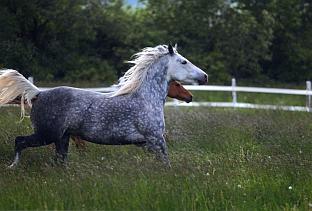Desert Norman Horse

Bred by Peggy Stockbridge, this is the magically beautiful EAF Remington's Jewel, a registered Desert Norman sired by Remington Steele (Arabian) out of Royal Crest Betty (percheron).

Country of Origin: Normandy, France
The information below, as well as the photo, have been taken directly from the Desert Horse Registry. Credit has been given for both text and photo. I have contacted the site for permission to use both photo and text and have been granted permission to use.
History
"The Desert Norman is essentially a very early form of the Percheron breed, which started out as a much more refined horse than the massive animal it is today. The breed began in La Perche, a district of Normandy southwest of Paris, France - one of the oldest horse-breeding areas in the world. Here in 732 A.D., Arabian horses abandoned by Moors after their defeat in the Battle of Tours, were crossed with the massive Flemish stock and from this cross came the Percheron type which has endured for twelve centuries.
During the Crusades, further infusions of Arab blood were made. Arab sires procured in the Holy Land were bred to the Percheron. In the early 1800s the French Government's Stud at La Pin introduced further Arab blood into the Percheron breed by covering selected mares with two outstanding grey Arab sires. Now all contemporary Percherons share this common heritage - grey or black in color - courtesy of the foundation stock that originated in Le Perche.
This cross created a versatile horse suited for driving, riding or farm work. But as the Industrial Revolution dawned at the beginning of the Nineteenth Century, the changing demands for agriculture and transportation began favoring a heavier animal, and Percheron breeders responded by producing the large and powerful horse we know today.
Now, the breed is coming full circle back to its early roots, its popularity fuelled by modern-day horse people involved in all manner of recreational and competitive equestrian activity. The ancient, elegant and endlessly versatile Arab-Percheron melding which began 1200 years ago, has a newfound following.
We have named this breed, the Desert Norman, in honor of its two founding bloodlines."
Characteristics (Breed Standard: Be advised that the current breed standard is a draft version, and may change somewhat in the future)
- "BODY TYPE - Generous but balanced proportions. Deep through the heart and body. An overall impression of close-coupled strength and refinement.
HEIGHT - Can vary depending on mare’s size, with arab mares producing more cob-sized offspring than percheron mares. The latter is the preferred method, producing offspring reaching 15 hands to 16.2 hands high.
- COAT - Usually grey or very dark bay. Lighter bays less common. White markings on legs uncommon.
- TEMPERAMENT - A calm intelligence and willing, sociable manner manifested in alertness, curiosity, and ability to form a loyal bond with human handlers. A tractable and easy keeper, with a positive attitude to its work.
- MOVEMENT - Naturally balanced and rhythmic stride, moving freely from the shoulder, excellent impulsion and agility.
- APTITUDE - Strength, athleticism, and calm focus make Desert Normans steady and versatile performers. The breed does well in dressage. With its powerful thrusting hindquarters, most are good, and sometimes, excellent jumpers. Good endurance for eventing and competitive trail riding. They are also naturals for pleasure and competitive driving. Good family and pleasure horses, able to carry weight, but calm enough for young riders.
- HEAD - Attractive and well proportioned, clean and refined forehead, muzzle, and ears, all speaks to the Arabian influence. Eyes are large and prominent, expressive and confident.
- NECK - Of medium length and arched, defined through the throatlatch, joining cleanly to the shoulder, and wider at the base of the windpipe where it joins the chest.
WITHERS - Well defined and long, with a smooth transition from the back to the neck, and higher than the croup.
- CHEST - Of medium to broad size, deep and muscular.
- RIBCAGE - Well developed, long and deep with the ribs obliquely arched into the joint with the spinal column which promotes a short and full flank.
SHOULDERS - Long, slanting and well muscled.
- BACK - Short, strong, well defined and tending towards the horizontal making a smooth union between the withers.
- LOINS - Short, wide, muscular, slightly convex, well connected with the back and croup with which they form a continuous harmonious line.
- CROUP - Fairly long and relatively level. Length and width should be of similar proportions, the profile convex and harmonious. The tail emerges from the same line as the croup.
- LEGS - The forelegs are well muscled and set squarely under the shoulders, longer upper arms, shorter cannons, generous bone, broad flat knees. Pasterns are strong, sloping with good length, but not overly long. Stifles average to low-set, well-muscled gaskins, broad, clean hocks. Average joint angles. Back leg not too straight, or too angled.
- HOOF - Of generous size, with dense, strong bone. Strong hoof walls and soles, and wide, well-angled heels permit horse to remain comfortably barefoot under most conditions."
|
